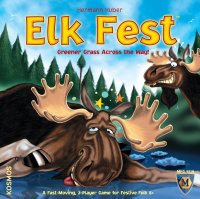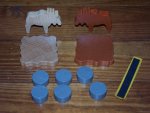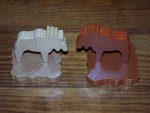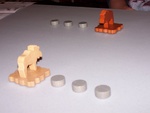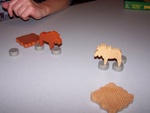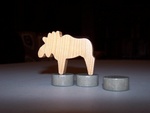
|
Elk Fest A game by Hermann Huber Published by Kosmos Games and distributed in the US by Mayfair Games, Inc. Players: 2 Time: 15 minutes Reviewed by Susan Rozmiarek |

|
The theme of Elk Fest revolves around the old saying that "the grass is always greener on the other side of the fence." Only in this case, that better grass is on the other side of a river. Players try to maneuver their moose across stepping stones to their opponent's riverbank by "flicking" the stones into position. It is a dexterity game along the lines of other "flicking" games like PitchCar or Crokinole but in a much smaller package. The game was initially published in German by Kosmos as Elchfest in 1999 as part of their series of games for two players. This new edition is being published in English by Mayfair Games.
Components:
The game comes in one of the small, square boxes like those of the other games in the Kosmo two-player line. The art is very whimsical and cute. The box feels very lightweight and upon opening, it is quite apparent why. There are not very many components in this game - just a rulebook and ten wooden pieces. The pieces are all of exceptionally good quality but game seems to be a bit overpriced for what one gets. Here are the complete contents:
- Rulebook: Single-folded rules printed in color for a total of four pages. The rules are clearly written with nice illustrations
- Two wooden moose, one dark and one light-colored. They are each just over two inches long
- Two wooden riverbanks, one dark and one light to match the moose. These are a little over two inches square. There are little squares of foam rubber that peel and stick to the bottom to keep them from sliding.
- Six gray wooden discs that represent stones. These are slightly less than one inch in diameter.
- A cardboard insert with the same goofy moose art as the box cover. I do like the art.
Game play:
On a player's turn, he flicks two stones and moves his moose as much as he can and/or wants to, before, during and/or after each stone is flicked. The moose must end up with both front and back hooves on a riverbank or stone and with each move his back hooves must end up on the location that the front hooves just vacated. In other words, no jumping allowed! Moose can turn around and both moose can be standing on the same stone. The player who takes the first move of the game only gets to flick one stone that turn and both players must flick all of their starting stones in their first two turns. After that, all the stones are fair game and can be used and flicked by either player. The first player to get his moose on the other player's riverbank wins the game.
This would all be rather easy if it weren't for the fact that these moose are very averse to getting wet. Apparently, they catch cold rather easily and thus there are severe penalties if a player allows a moose to touch the "water" (table) on his turn, even if he is just holding the moose in his hand, testing the distance between two stones. Of course, this applies to any moose knocked over as well. The wet moose is put back in his last dry position as are any flicked stones. The clumsy player's turn ends immediately and his opponent gets to make three stone flicks on his next turn. If a player is really clumsy and actually flicks a stone off the table, his turn ends immediately and the fallen stone is placed to the right of his riverbank. His opponent once again gets three stone flicks on his next turn. Being able to flick an additional stone is quite powerful, especially toward the end of the game, so you want to keep those moose out of the water.
Comments:
The game starts out slowly as both moose venture out toward the middle of the table.
It gets more interesting as they near each other since the very stones you've left behind leave a perfect
trail to your riverbank for your opponent's moose.
Now, you must try to flick stones that not only help you but also hinder your opponent.
The last part of the game is often a hurried dash for the riverbanks with one moose just a step ahead of the other.
I must admit, I have never been a real fan of this sort of dexterity game although I don't mind playing them occasionally. Games like this seem to be more of an activity in the same vein as those little paper footballs my classmates and I used to make in grade school to flick around. When it comes to games, I prefer more of a mental challenge or games of chance. However, games like Crokinole and PitchCar seem to have plenty of fans who may enjoy Elk Fest for the same reasons. It's not nearly as big and impressive as those other two, but it does have a few advantages in that it doesn't take a lot of space and is very portable, making it an ideal game to take and play in a restaurant or pub. It is a nice introductory "flicking" game and a good way to try this sort of game without investing a lot of money. So, if this sort of dexterity game appeals to you, Elk Fest is probably worth a look.
| Other Web information: |
This page viewed
E-mail Ed Rozmiarek with questions or problems concerning this page.
Copyright © 2007, Ed & Susan Rozmiarek. No portion of this website may be reproduced or copied without the consent of Ed or Susan Rozmiarek.
